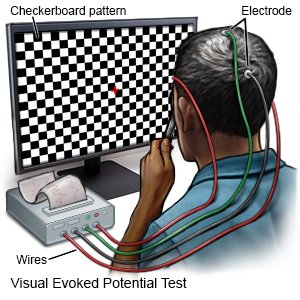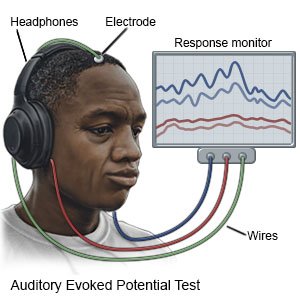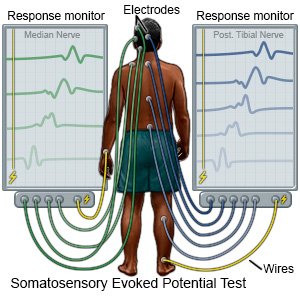Evoked Potential Tests
Medically reviewed by Drugs.com. Last updated on Aug 4, 2025.
What are evoked potential tests?
Evoked potential tests measure the electrical activity in your brain in response to sight, sound, or sensation. Each of these senses trigger electrical signals in your brain. These signals are recorded and measured by electrodes attached to your body. Electrodes are small patches with wires that connect your body to a machine. The 3 most common types of evoked potential tests include visual (sight), auditory (hearing), and somatosensory (touch). These tests do not hurt, the electrodes simply record activity.
What are evoked potential tests used for?
- To help identify conditions, such as multiple sclerosis, migraines, or the presence of tumors
- To measure pain in conditions such as peripheral neuropathy, lumbar stenosis, or nerve injury
- To test hearing or sight in babies or children
- To check brain function of someone in a coma
How do I prepare for an evoked potential test?
There is usually no preparation needed for an evoked potential test. You may need to wash your hair the night before the procedure.
What will happen during the 3 evoked potential tests?
- The visual evoked potential (VEP) test measures your brain's response to visual triggers. Electrodes are placed on your scalp. A checkerboard pattern will flash on a screen for several minutes. Your brain's response to the pattern will be measured and recorded. A bright flashing light may be used instead for children or if your vision is impaired.

- The auditory evoked potential (AEP) test measures your brain's response to sound. Electrodes are placed on your scalp and earlobes. Sounds, such as clicks or tones, will be played. Your brain's response to the sound will be measured and recorded.

- The somatosensory evoked potential (SER) test measures your brain's response to sensation, or touch. Electrodes are attached to your scalp, wrist, the back of your knee, or other body parts. A mild electrical signal is sent through the electrodes to your body. The electrodes on your head measure the amount of time it takes for the signal to reach your brain. This test measures numbness or weakness of your limbs.

Care Agreement
You have the right to help plan your care. Learn about your health condition and how it may be treated. Discuss treatment options with your healthcare providers to decide what care you want to receive. You always have the right to refuse treatment. The above information is an educational aid only. It is not intended as medical advice for individual conditions or treatments. Talk to your doctor, nurse or pharmacist before following any medical regimen to see if it is safe and effective for you.© Copyright Merative 2025 Information is for End User's use only and may not be sold, redistributed or otherwise used for commercial purposes.
Further information
Always consult your healthcare provider to ensure the information displayed on this page applies to your personal circumstances.
